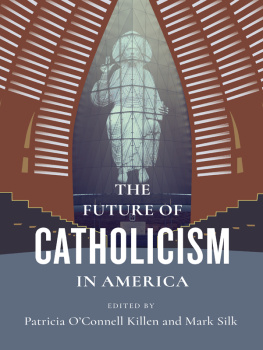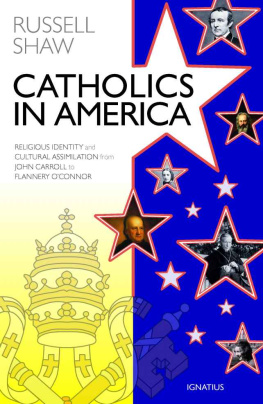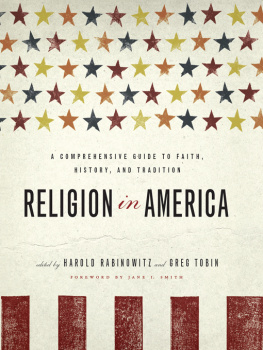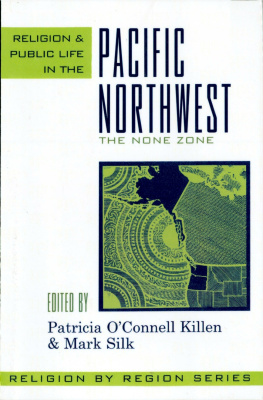Table of Contents
The Future of Catholicism in America
THE FUTURE OF RELIGION IN AMERICA
THE FUTURE OF RELIGION IN AMERICA
Series Editors Mark Silk and Andrew H. Walsh
The Future of Religion in America is a series of edited volumes on the current state and prospects of the principal religious groupings in the United States. Informed by survey research, the series explores the effect of the significant realignment of the American religious landscape that consolidated in the 1990s, driven by the increasing acceptance of the idea that religious identity is and should be a matter of personal individual choice and not inheritance.
The Future of Evangelicalism in America, edited by Candy Gunther Brown and Mark Silk
The Future of Mainline Protestantism in America, edited by James Hudnut-Beumler and Mark Silk
THE FUTURE OF CATHOLICISM IN AMERICA
EDITED BY
Patricia OConnell Killen and Mark Silk
Columbia University Press
New York
Columbia University Press
Publishers Since 1893
New York Chichester, West Sussex
cup.columbia.edu
Copyright 2019 Columbia University Press
All rights reserved
E-ISBN 978-0-231-54943-1
Library of Congress Cataloging-in-Publication Data
Names: Killen, Patricia OConnell, editor.
Title: The future of Catholicism in America / edited by Patricia OConnell Killen and Mark Silk.
Description: New York: Columbia University Press, 2019. | Series: The future of religion in America | Includes bibliographical references and index.
Identifiers: LCCN 2018039213 (print) | LCCN 2018053784 (e-book) | ISBN 9780231549431 (e-book) | ISBN 9780231191487 (cloth: alk. paper) | ISBN 9780231191494 (pbk.: alk. paper)
Subjects: LCSH: Catholic ChurchUnited StatesHistory21st century.
Classification: LCC BX1406.3 (e-book) | LCC BX1406.3 .F88 2019 (print) | DDC 282/.7309051dc23
LC record available at https://lccn.loc.gov/2018039213
A Columbia University Press E-book.
CUP would be pleased to hear about your reading experience with this e-book at .
Cover design: Lisa Hamm
Cover image: Cathedral of Christ the Light The Catholic Voice
Contents
Mark Silk and Andrew H. Walsh
Patricia OConnell Killen
William D. Dinges
Timothy Matovina
Steven M. Avella
Katarina Schuth
Joseph P. Chinnici
Andrew H. Walsh
Richard L. Wood
Patricia OConnell Killen
Mark Silk and Andrew H. Walsh
What is the future of religion in America? Not too good, to judge by recent survey data. Between 1990 and 2015, the proportion of adults who said they had no religionthe so-called Nonesincreased from the middle single-digits to over 20 percent, a startling rise and one that was disproportionately found among the rising Millennial generation. If the Millennials remain as they are, and the generation after them follows their lead, one-third of Americans will be Nones before long. To be sure, there are no guarantees that this will happen; it has long been the case that Americans tend to disconnect from organized religion in their twenties, then reaffiliate when they marry and have children. It is also important to recognize that those who say they have no religion are not saying that they have no religious beliefs or engage in no religious behavior. Most Nones in fact claim to believe in God, and many engage in a variety of religious practices, including prayer and worship attendance. Meanwhile, nearly four in five Americans continue to identify with a religious body or traditionChristian for the most part but also Jewish, Muslim, Hindu, Buddhist, Sikh, Bahai, Wiccan, New Age, and more. How have these various traditions changed? Which have grown and which declined? What sorts of beliefs and practices have Americans gravitated toward and which have they moved away from? How have religious impulses and movements affected public policy and the culture at large? If we are to project the future of religion in America, we need to know where it is today and the trajectory it took to get there.
Unfortunately, that knowledge is not easy to come by. For nearly half a century, the historians who are supposed to tell the story of religion in America have shied away from bringing it past the 1960s. One reason for this has been their desire to distance themselves from a scholarly heritage they believe to have been excessively devoted to Protestant identities, perspectives, and agendas. Placing Protestantism at the center of the story has seemed like an act of illegitimate cultural hegemony in a society as religiously diverse as the United States has become over the past half-century. Textbook narratives that attempt to tell the whole story of U.S. religious history have focused disproportionately on male, northeastern, Anglo-Saxon, mainline Protestants and their beliefs, institutions, and power, Thomas A. Tweed wrote in 1997, in a characteristic dismissal. Indeed, any attempt to construct a master narrative of the whole story has been deemed an inherently misleading form of historical discourse.
In recent decades, much of the best historical writing about religion in America has steered clear of summary accounts altogether, offering instead tightly focused ethnographies, studies based on gender and race analysis, meditations on consumer culture, and monographs on immigrants and outsiders and their distinctive perspectives on the larger society. Multiplicity has been its watchword. But as valuable as the multiplicity approach has been in shining a light on hitherto overlooked parts of the American religious landscape, it can be just as misleading as triumphalist Protestantism. To take one prominent example, in 2001 Diana Ecks A New Religious America: How a Christian Country Has Become the Worlds Most Religiously Diverse Nation called for an end to conceptualizing the United States as in some sense Christian. Because of the 1965 immigration law, members of world religions were now here in strength, Eck (correctly) claimed. What she avoided discussing, however, was the relative weight of the world religions in society as a whole. As it turns out, although twenty-first-century America counts millions of Muslims, Hindus, Buddhists, Jains, Sikhs, Taoists, and adherents of other world religions in its population, they total less than 5 percent of the population. Moreover, Eck omitted to note that the large majority of post-1965 immigrants have been Christianfor the most part Roman Catholics. Overall, close to three-quarters of Americans still identify as Christians of one sort or another.
While there is no doubt that the story of religion in America must account for the growth of religious diversity, since the 1970s substantial changes have taken place that have nothing to do with it. There is, we believe, no substitute for comprehensive narratives that describe and assess how religious identity has changed and what the developments in the major religious institutions and traditions have beenand where they are headed. That is what the Future of Religion in America series seeks to provide. For the series, teams of experts have been asked to place the tradition they study in the contemporary American context, understood in quantitative as well as qualitative terms.











